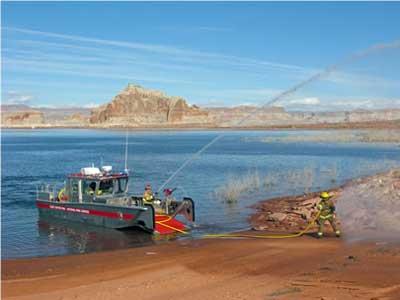One of the intriguing aspects of the work of national park rangers is the wide variety of duties their jobs can entail, but the staff at Glen Canyon National Recreation Area has a unique distinction: The park is home to perhaps the most active NPS-owned and operated fireboat program in the country.
A new fireboat was launched on Lake Powell this past November, and allows Glen Canyon National Recreation Area to upgrade its capacity for responding to marine fires and wildland fires close to the lakeshore.
Why a fireboat on a lake in the middle of the desert?
The combination of large numbers of boats moored in close quarters and the presence of a lot of flammable fuel makes any marina fire potentially dangerous and expensive, and Glen Canyon's remote location limits the availability of backup from other departments. The park staff responds to an average of 20 boat fires and 15 fuel spills on Lake Powell each year, and the Traveler has reported on several of those incidents.
The new fireboat is staged at Wahweap, where it is readily available as the primary resource for protecting Wahweap Marina, Antelope Point Marina, boat rental docks, buoy fields, fuel docks, and boats on the southern end of Lake Powell. This new fire boat replaces an older boat with limited capabilities that was in service for over a decade.
Park structural firefighters had the fire boat custom-built for the specific needs of the recreation area. The 32-foot boat has an 11-foot beam, a 1,000 gallon per minute pump, and a built-in foam proportioner. The boat is faster than its predecessor, has a greater pump capacity, and also has more storage. It has twin diesel engines and its bow thrusters provide greater stability.
The new boat is also more versatile than its predecessor. A park spokesperson notes, "Firefighters can now safely move around the perimeter of the vessel in turnout gear, can access the water from all four sides of the boat, and can more safely reach land through the landing craft style bow door." The boat is equipped with the same structural firefighting equipment as a structural fire engine.
The National Park Service’s structural fire program based in Boise, Idaho, helped fund the boat. It will be used to help train structural firefighters from around the country in marine firefighting as part of a national structural fire training program hosted at Glen Canyon.
A small number of other NPS areas, including Lake Mead National Recreation Area and Gateway National Recreation Area, are also home to small fireboats, but many of those vessels are either operated primarily by concessioners or are used mainly for water-based support of wildland fires near the shoreline. Other parks must rely on portable pumps that can be carried on boats when needed to combat fires in boats or near the shore.
Boat fires, whether the vessel is afloat on a lake or river or docked at a marina, are always a challenging and dangerous situation. This addition to the park fleet at Glen Canyon will be a plus for the staff, concessioners and visitors.




Add comment